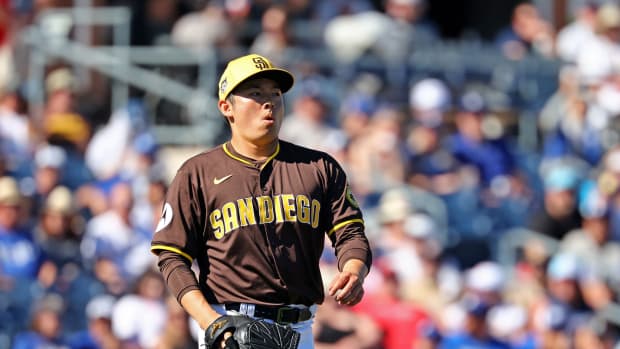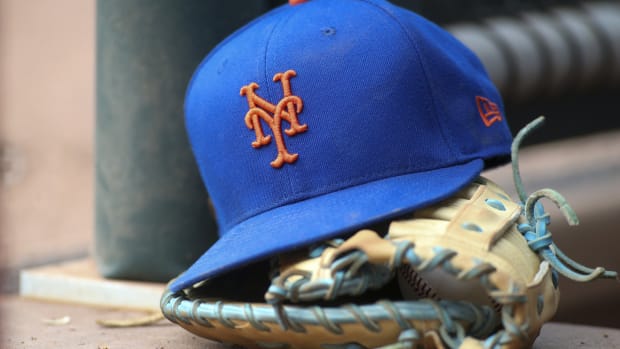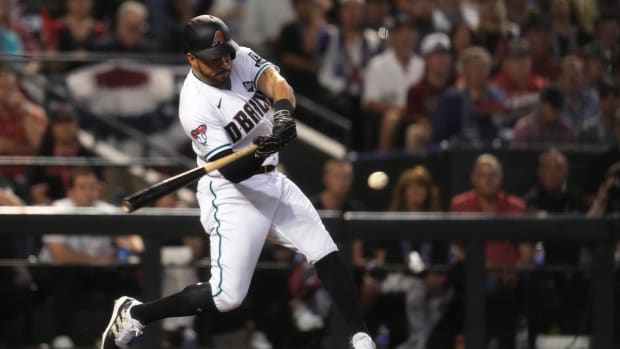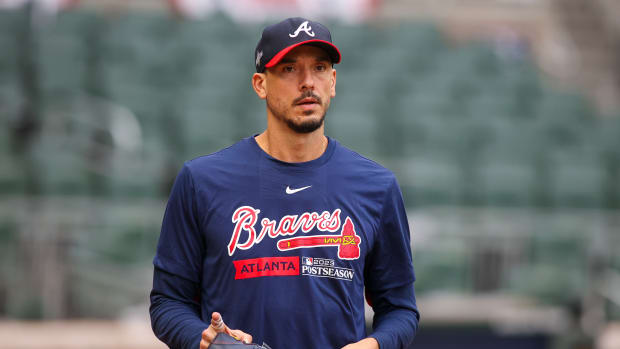Hall hopes bleak for Bonds, Clemens; plus, my ballot and more thoughts
Barry Bonds and Roger Clemens remain stuck in the purgatory of Cooperstown. After three years of showing no traction with voting members of the Baseball Writers Association of America, Bonds and Clemens were supposed to make a leap forward on the 2016 ballot because of a major change in Hall of Fame voting rules: The Hall’s board culled all voters who have not been covering baseball for the last decade.
The theory for how the major change would benefit Bonds and Clemens went something like this: Crusty old guys go out, the electorate skews younger and more “progressive” (i.e., doping is a-okay), and Bonds and Clemens pick up a huge boost.
Didn't happen.
In the results announced Wednesday, even with 109 writers bounced from the voting rolls, Bonds moved only from 37% to 44%, and Clemens went from 38% to 45%—still far from the 75% needed for election. They did not show nearly enough momentum to be encouraged that they will ever be voted in by the writers. They have six more chances and likely will never again see a potential boost like they got from the culling of the voting rolls.
Three thoughts on Ken Griffey, Mike Piazza and 2016 Hall of Fame election
With 549 ballots last year, Bonds and Clemens needed 60–61% of the “no” voters to change their minds for election. With 440 ballots this year, Bonds and Clemens still needed 54–56% of the “no” voters to change their minds. That’s hardly much progress. Can you imagine more than half the people who don’t vote for those two because of their connections to steroids changing their mind on such a polarizing topic? A few? Sure. More than half? I don’t see it. (And yes, it’s not the same people voting every year, but you get the idea.)
Unless we see a major change in their momentum, you are looking at Bonds and Clemens going on a ballot of the 16-person Expansion Era committee in December 2026. Bonds will be 61 years old then; Clemens will be 63. Good luck getting voted in by a committee hand-picked by the Hall. There will be something of a sneak preview in 2019 when Mark McGwire, who received 12.3% in his 10th and final year on the writers’ ballot, is eligible for the Expansion Era ballot.
I did not vote for any of those three for the Hall of Fame this year. Here are the nine men I did check on my ballot: Ken Griffey Jr., Mike Piazza, Jeff Bagwell, Trevor Hoffman, Jeff Kent, Fred McGriff, Mike Mussina, Tim Raines and Curt Schilling.
The prospects of Bonds and Clemens are far from the only intriguing takeaways from the 2016 Hall of Fame election. Here’s what else we learned from Wednesday's results:
1. Ken Griffey Jr. is transcendent
Griffey (99.3%) eclipsed the record support given Tom Seaver (98.8%) in 1992 that had held up for more than two decades. He was the idol of a new generation, thanks to the way he wore his cap backward, the way he played with boyish joy and the fact that he rose to stardom as video games became popular and ESPN acquired rights to Major League Baseball games (he made his debut in April 1989, three months after the network signed its first deal with the league). He was, in short, seen in a way no superstar before him had been. He also played through the teeth of the Steroid Era and came out unscathed, with 630 home runs and unprecedented respect from the voters.
2. Jeff Bagwell and Tim Raines are likely to be elected next year
Bagwell (71.6%) and Raines (69.8%) are on the doorstep to Cooperstown, the same place where Piazza stood last year when he got 69.9%. Since 1968, 17 players received 69% of the vote or better with at least one more year remaining on the ballot. All of them, including Piazza, were elected the very next year, with one exception: Jim Bunning in 1988, who whiffed on three more chances but was eventually elected by the Veterans Committee.
Raines will have the added bonus of staring at his final year on the ballot. Bonus? Yes, players tend to pick up votes when it comes down to now-or-never. Alan Trammell, for instance, reached a career-high 40.9% this year, his 15th and final time on the ballot.
• JAFFE: Junior's achievement, future of ballot, full results, more
3. Trevor Hoffman turned in a very strong showing
The former Padres closer should be very encouraged about getting 67.3% of the vote in his first year on the ballot. Piazza had held the record for the best first-year showing without getting elected (57.8%, in 2013), a claim that now falls to Lee Smith (42.3% in 2003), who has one more year left. Hoffman will get elected eventually, and rightly so.
The save is a flawed statistic, but it is a stat that influences how managers run a game, and even allowing for its imperfections, Hoffman produced some staggering statistics. Aside from the peerless Mariano Rivera, Hoffman's career total of 601 saves is 26% more saves than anyone else, and his save percentage of 88.8 is better than that of any of the five closers already enshrined.
4. Curt Schilling and Mike Mussina are trending well
I always thought of Schilling as Don Drysdale with a better postseason resume, and so far, the returns on Schilling (38.8%, 29.2%, 39.2%, 52.3%) somewhat track those of Big D (21.0%, 29.4%, 51.4%, 587.8%). It took Drysdale 10 tries to get in. As for Mussina: In his third year on the ballot, he was the biggest winner of the day as ranked by percentage increase, gaining 18.4% from his 2015 showing (24.6% to 43.0%).
Both pitchers will continue to benefit from the lack of sure Hall of Fame starting pitchers coming on the ballot over the next several years. The only possible Hall of Fame starting pitchers to join the next four ballots are Roy Halladay and Andy Pettitte, both in 2019.
• MORE MLB: Do Zimmerman, Howard have a case against Al Jazeera?
5. Fred McGriff is not getting elected to the Hall of Fame
The Crime Dog received just 20.9% of the vote this year, still short of his best of just 23.9% in 2012, and he has only three more chances. His low support is strange: The guy is the spitting image of Hall of Famer Eddie Mathews, who started at 32.3% and was elected in his fifth year:
Player | G | H | HR | RBIs | AVG/OBP/SLG | OPS |
McGriff | 2,460 | 2,490 | 493 | 1,550 | .284/.377/.509 | .886 |
Mathews | 2,391 | 2,315 | 512 | 1,453 | .271/.376/.509 | .885 |
Why don’t more voters support McGriff? Three reasons: steroids, the 1994–95 player's strike and his itinerant career. Consider them in order, however.
Steroids: The dudes who cheated the game cheated guys like McGriff, whose numbers had once been good enough to win home run titles and establish him as an elite power hitter but suddenly looked puny. If you divide McGriff’s home runs virtually in half—before and after steroid use exploded—you can see how the juiced sluggers who were pounding out 50 or more home runs made McGriff look like just another hitter:
Time Range | McGriff HR TOTAL | MLB Rank |
1987–93 | 228 | 1st |
1994–2004 | 265 | 26th |
The 1994-95 strike: McGriff hit 61 home runs in his team’s 258 games in those two seasons. He missed 66 games due to the strike, which equates to 16 lost homers. McGriff finished his career with 493 home runs. If he hits 500, he gets the career retrospective, adulation and appreciation he never actually received.
No flagbearers: McGriff played with six teams, none for more than five years. Compared to Hall of Famer Eddie Murray, he has a better on-base percentage, a better slugging percentage and a better adjusted OPS, as well as more 30-homer seasons and more 100-RBI seasons. But Murray was associated with one team (the Orioles), giving him a strong narrative with voters.
6. Next year's vote will be far more intriguing than this one
Bagwell and Raines are on the doorstep, Hoffman is well within striking distance of enshrinement, and Vladimir Guerrero will be the best newcomer in 2017. Only eight players ever appeared on a ballot with these three thresholds that Guerrero passed: a .300 average, 2,500 hits and 400 homers. The others? Babe Ruth, Lou Gehrig, Mel Ott, Jimmie Foxx, Ted Williams, Stan Musial, Hank Aaron and Willie Mays. Whew. He should get in, but who knows?
Ivan Rodriguez, a 14-time All-Star and 13-time Gold Glover at catcher, is also on the ballot, but there is the issue of Jose Canseco writing in Juiced that he injected Rodriguez with steroids when they were teammates in Texas (Rodriguez is not known to have failed a PED test and has not been otherwise linked to steroids). And Manny Ramirez has no shot despite his 555 career home runs because he failed two drug tests.
That leaves four players—Bagwell, Raines, Hoffman and Guerrero—with a very good chance of being elected, but any of them also could fall below the magic 75% mark.


































